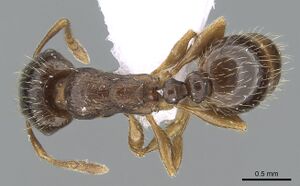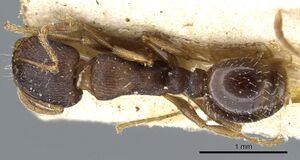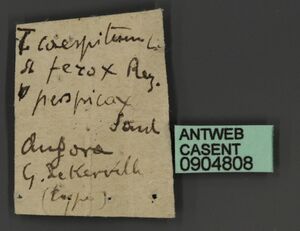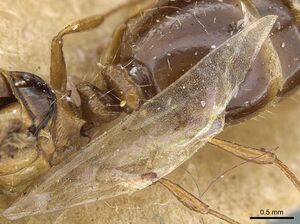Tetramorium ferox
| Tetramorium ferox | |
|---|---|

| |
| Scientific classification | |
| Kingdom: | Animalia |
| Phylum: | Arthropoda |
| Class: | Insecta |
| Order: | Hymenoptera |
| Family: | Formicidae |
| Subfamily: | Myrmicinae |
| Tribe: | Crematogastrini |
| Genus: | Tetramorium |
| Species: | T. ferox |
| Binomial name | |
| Tetramorium ferox Ruzsky, 1903 | |
| Synonyms | |
| |
Very little is known about the biology of T. ferox, other than it is a host for the inquilines Strongylognathus karawajewi and Strongylognathus testaceus.
Identification
Csösz and Schulz (2010) - A member of the Tetramorium ferox species complex in the Tetramorium caespitum species group. The feebly rugulose general sculpture, the microreticulate ground surface, and the relatively sparse pubescence on the first gastral tergite make the T. ferox gynes unique within this group.
Tetramorium ferox workers cannot be confused with those of Tetramorium diomedeum or Tetramorium aegeum. The general appearance of the head and mesosoma of T. ferox workers is always rugulose, microreticulate and dull, but head and mesosoma of the latter two species are always shiny and usually at least partly smooth.
Tetramorium feroxoides workers usually bear much feebler (and often parallel) rugulae on head and mesosoma than T. ferox workers, but in a few cases T. feroxoides workers can be confused with the smallest T. ferox workers.
A discriminant function using various morphological measurements has also been defined and can be used to make determinations in this species group.
Keys including this Species
Distribution
Widely distributed over the western Palaearctic, from Central Europe to the Caucasus and Turkey. (Csösz and Schulz 2010)
Latitudinal Distribution Pattern
Latitudinal Range: 51.566667° to 24.633333°.
| North Temperate |
North Subtropical |
Tropical | South Subtropical |
South Temperate |
- Source: AntMaps
Distribution based on Regional Taxon Lists
Palaearctic Region: Armenia, Azerbaijan, Bulgaria, China, Croatia, Czechia, Georgia, Greece, Hungary, Iran, Kyrgyzstan, Malta, Montenegro, North Macedonia, Romania, Russian Federation (type locality), Türkiye, Turkmenistan.
Distribution based on AntMaps
Distribution based on AntWeb specimens
Check data from AntWeb
Countries Occupied
| Number of countries occupied by this species based on AntWiki Regional Taxon Lists. In general, fewer countries occupied indicates a narrower range, while more countries indicates a more widespread species. |

|
Estimated Abundance
| Relative abundance based on number of AntMaps records per species (this species within the purple bar). Fewer records (to the left) indicates a less abundant/encountered species while more records (to the right) indicates more abundant/encountered species. |

|
Biology
Castes
Worker
Images from AntWeb
   
| |
| Worker. Specimen code casent0281567. Photographer Estella Ortega, uploaded by California Academy of Sciences. | Owned by CAS, San Francisco, CA, USA. |
   
| |
| Syntype of Tetramorium ferox. Worker. Specimen code casent0904806. Photographer Z. Lieberman, uploaded by California Academy of Sciences. | Owned by MSNG, Genoa, Italy. |
   
| |
| Type of unavailable quadrinomial: Tetramorium caespitum ferox perspicax. Worker. Specimen code casent0904808. Photographer Z. Lieberman, uploaded by California Academy of Sciences. | Owned by MSNG, Genoa, Italy. |
Queen
Images from AntWeb
    
| |
| Type of unavailable quadrinomial: Tetramorium caespitum ferox striaticeps. Queen (alate/dealate). Specimen code casent0904804. Photographer Z. Lieberman, uploaded by California Academy of Sciences. | Owned by MSNG, Genoa, Italy. |
Nomenclature
The following information is derived from Barry Bolton's Online Catalogue of the Ants of the World.
- ferox. Tetramorium caespitum var. ferox Ruzsky, 1903b: 309 (w.q.m.) RUSSIA. Subspecies of caespitum: Emery, 1909d: 703; Emery, 1916b: 194. Raised to species: Cori & Finzi, 1931: 239; Soudek, 1931: 10; Menozzi, 1933b: 75 (in key); Kratochvíl, 1944: 72; Tarbinsky, 1976: 112; Atanassov & Dlussky, 1992: 155. Senior synonym of silhavyi: Bernard, 1967: 235; Dlussky, Soyunov & Zabelin, 1990: 201; Radchenko, 1992b: 55; of confinis, perspicax: Csösz & Schulz, 2010: 20; material of the unavailable name striaticeps referred here by Radchenko, 1992b: 55.
- silhavyi. Tetramorium (Lobomyrmex) ferox subsp. silhavyi Kratochvíl, in Novak & Sadil, 1941: 84, fig. 1 (w.q.) CZECHOSLOVAKIA. [Also described as new by Kratochvíl, in Kratochvíl, Novak & Snoflak, 1944: 72.] Junior synonym of ferox: Bernard, 1967: 235; Radchenko, 1992b: 55.
- confinis. Tetramorium confinis Radchenko & Arakelian, 1990: 374, fig. 2 (w.q.m.) ARMENIA. Junior synonym of ferox: Csösz & Schulz, 2010: 20.
- perspicax. Tetramorium perspicax Radchenko, 1992b: 56 (w.q.) TURKEY. [First available use of Tetramorium caespitum st. ferox var. perspicax Santschi, 1921a: 111; unavailable name.] Synonym of feroxoides: Radchenko, 1992b: 56. [Radchenko gives perspicax as senior name, but feroxoides has priority: Bolton, 1995b: 412.] Junior synonym of ferox: Csösz & Schulz, 2010: 21.
Type Material
Csösz and Schulz (2010) - Syntype workers, gynes, male (2w, 2q, 1m): Russia, Saratov (Ruzsky) [labels: Tetr. caespitum L., v. ferox Rusz, Ssaratov M.R.] (examined) Museo Civico di Storia Naturale, Genoa, Musee d'Histoire Naturelle Genève.
Bezděčková et al. (2017) - Tetramorium ferox silhavyi: Five syntypes are deposited in Museum of the Highlands, Jihlava, Czech Republic (all dry-mounted):
- SYNTYPES (3 males 1 alate queen each glued on a small rectangular label and all together on one larger card label ca. 40 × 16 mm): ‘Tetramorium / ferrox [sic] / Šilhavýi. Krat. [hw] // Tetramorium ferrox [sic] / worker šilhavýi Krat. / Mohelno, cotypy, 05062 [hw] // Syntypus / (Bezděčková et al. 2017) [p, red label]’ [IN: E26-T10–E26-T13].
- SYNTYPE (1 dealate queen, only head with one antenna and thorax with one leg glued on a card label ca. 40 × 16 mm): ‘Tetramorium / ferrox [sic] / šilhavýi Krat. [hw] // Tetramorium ferrox [sic] / šilhavýi Krat. / Mohelno – paratyp, 05063 [hw] // Syntypus / (Bezděčková et al. 2017) [p, red label]’ [IN: E26-T14].
Remarks. The description was originally prepared by Josef Kratochvíl for publication in the proceedings on the fauna of the Mohelno serpentine steppe, which was, however, released later (KRATOCHVÍL 1944) than the identification key by NOVÁK & SADIL (1941) including a short description based on Kratochvíl’s manuscript and citing Kratochvíl as the author of the new name. Therefore, the text in NOVÁK & SADIL (1941) has priority for nomenclature.
Neither NOVÁK & SADIL (1941) nor KRATOCHVÍL (1944) provided any information on the number of the type specimens or the type locality; they only stated that T. ferox silhavyi was known from Moravia, Slovakia and Hungary. Based on the fact that the taxon was listed among new forms of ants discovered in the Mohelno serpentine steppe (KRATOCHVÍL 1944) and based on the locality data of the specimens in Museum of the Highlands, Jihlava, Czech Republic, at least a part of the type series was collected in Mohelno (Czech Republic, Moravia). Four specimens deposited in Museum of the Highlands, Jihlava, Czech Republic were originally labelled as cotypes (“cotypy”) and one specimen as a paratype, but no specimen designated as a holotype is available. Therefore, we consider all these specimens syntypes.
Unless otherwise noted the text for the remainder of this section is reported from the publication that includes the original description.
Description
Worker
Csösz and Schulz (2010) - Medium to large size, CS 825 [693, 918]. Whole body and appendages greyish brown to dark brown. Head slightly longer than broad, CL/CW 1.03 [0.99, 1.09], with feebly convex sides, straight posterior margin with widely rounded corners. Eyes small, EYE 0.16 [0.15, 0.18]. Frons moderately wide, FR/CS 0.39 [0.36, 0.41], frontal lobes usually as wide as the frons, rarely slightly broader, FL/FR 1.01 [1.00, 1.03]. Scape long, SL/CS 0.79 [0.74, 0.83], with a feeble dorsal carina basally, its surface very finely microreticulate. Promesonotal dorsum slightly convex, metanotal groove shallow. Propodeal denticles moderately long. Petiolar node moderately high, NOH/NOL 1.05 [0.88, 1.29] trapezoid to cubic seen in profile.
Head longitudinally rugulose and microreticulate, posterior surface ruguloso-reticulate, ground surface microreticulate, appears dull. Mesosoma dorsum and mesopleura ruguloso-reticulate, ground surface coarsely microreticulate. Dorsum of petiolar node ruguloso-reticulate, ground surface microreticulate, median part smooth. Dorsum of postpetiole rugulose and microreticulate. First gastral tergite smooth, appears shiny. Ventral surface of head with a row of short setae only (without long C-shape hairs).
Queen
Csösz and Schulz (2010) - Medium to large size, CS 999 [955, 1095]. Whole body and appendages black. Head broader than long, CL/CW 0.92 [0.90, 0.94] with sides and posterior margin straight, with widely rounded corners. Head trapezoid in full face view, narrower at genae. Frons moderately wide, FR/CS 0.40 [0.39, 0.42]. Scape long, SL/CS 0.75 [0.70, 0.81], with a feeble dorsal carina basally, its surface smooth and shiny. Head slightly narrower than scutum, MW/CS 1.03 [0.99, 1.08]. Propodeal teeth long. Petiole and postpetiole wide, CS/PEW 1.65 [1.56, 1.78], CS/PPW 1.29 [1.11, 1.43].
Head dorsum, posterior surface and sides ruguloso-reticulate, ground surface microreticulate. Frons longitudinally rugulose and microreticulate. Scutum and scutellum longitudinally rugulose. Sides of mesosoma, rugoso-reticulate and microreticulate, ventral part of katepisternum always rugulose, or microreticulate. Dorsum of petiolar node and postpetiole coarsely reticulate and microreticulate. First gastral tergite smooth, appears shiny. Ventral surface of head with a row of short setae only (without long C-shape hairs).
Male
Csösz and Schulz (2010) - Head sides feebly convex, posterior margin widely rounded. Scutum much broader than head. Propodeal denticles reduced, propodeum nearly rounded in profile. Dorsum of petiolar node blunt, dorsolaterally sharp and angulate. Whole body and appendages black. Head, scutum, scutellum, anepi- and katepisternum as well as petiole and postpetiole finely rugulo-reticulate, between main sculpturation microreticulate. First gastral tergite smooth, appears shiny.
References
- Atanassov, N.; Dlussky, G. M. 1992. Fauna of Bulgaria. Hymenoptera, Formicidae. Fauna Bûlg. 22: 1-310 (page 155, Raised to species)
- Bernard, F. 1967a [1968]. Faune de l'Europe et du Bassin Méditerranéen. 3. Les fourmis (Hymenoptera Formicidae) d'Europe occidentale et septentrionale. Paris: Masson, 411 pp. (page 235, Senior synonym of silhavyi)
- Bezděčková, K., Bezděčka, P., Macek, J., Malenovský, I. 2017. Catalogue of type specimens of ants (Hymenoptera: Formicidae) deposited in Czech museums. Acta Entomologica Musei Nationalis Pragae 57(1): 295-308 (doi:10.1515/aemnp-2017-0076).
- Borowiec, L. 2014. Catalogue of ants of Europe, the Mediterranean Basin and adjacent regions (Hymenoptera: Formicidae). Genus (Wroclaw) 25(1-2): 1-340.
- Borowiec, L., van Delft, J.P.L., van Delft, J.J.C.W., Salata, S. 2023. Five ant species (Hymenoptera: Formicidae) new to the Greek fauna with notes on ants from Greek Thrace. Annales of the Upper Silesian Museum in Bytom, Entomology 32 (online 008), 1-13 (doi:10.5281/ZENODO.10101028).
- Bracko, G., Wagner, H.C., Schulz, A., Gioahin, E., Maticic, J., Trantnik, A. 2014. New investigation and a revised checklist of the ants (Hymenoptera: Formicidae) of the Republic of Macedonia. North-Western Journal of Zoology 10: 10-24.
- Cori, K.; Finzi, B. 1931. Aufzählung der von Karl Cori 1914 auf süddalmatinischen Inseln gesammelten Ameisen. Anz. Akad. Wiss. Wien Math.-Naturwiss. Kl. 68: 237-240 (page 239, Raised to species)
- Csösz, S. & Schulz, A. 2010. A taxonomic review of the Palaearctic Tetramorium ferox species-complex. Zootaxa. 2401:1-29.
- Csosz, S. ; Marko, B. 2004. Redescription of Tetramorium hungaricum Roeszler, 1935, a related species of T. caespitum (Linnaeus, 1758) (Hymenoptera: Formicidae). Myrmecologische Nachrichten 6: 49-59 (page 55, diagnostic characters)
- Csősz, S., Báthori, F., Gallé, L., Lőrinczi, G., Maák, I., Tartally, A., Kovács, É., Somogyi, A.Á., Markó, B. 2021. The myrmecofauna (Hymenoptera: Formicidae) of Hungary: Survey of ant species with an annotated synonymic inventory. Insects 16;12(1):78 (doi:10.3390/insects12010078).
- Csosz, S., Marko, B., Galle, L. 2011. The myrmecofauna (Hymenoptera: Formicidae) of Hungary: an updated checklist. North-Western Journal of Zoology 7: 55-62.
- Dlussky, G. M.; Soyunov, O. S.; Zabelin, S. I. 1990 [1989]. Ants of Turkmenistan. Ashkhabad: Ylym Press, 273 pp. (page 201, Senior synonym of silhavyi)
- Emery, C. 1909f. Beiträge zur Monographie der Formiciden des paläarktischen Faunengebietes. (Hym.) Teil IX. Dtsch. Entomol. Z. 1909: 695-712 (page 703, Subspecies of caespitum)
- Emery, C. 1916a [1915]. Fauna entomologica italiana. I. Hymenoptera.-Formicidae. Bull. Soc. Entomol. Ital. 47: 79-275 (page 194, Subspecies of caespitum)
- Kiran, K., Karaman, C. 2020. Additions to the ant fauna of Turkey (Hymenoptera, Formicidae). Zoosystema 42(18), 285-329 (doi:10.5252/zoosystema2020v42a18).
- Kiran, K., Karaman, C., Lapeva-Gjonova, A., Aksoy, V. 2017. Two new species of the “ultimate” parasitic ant genus Teleutomyrmex Kutter, 1950 (Hymenoptera: Formicidae) from the Western Palaearctic. Myrmecological News 25: 145–155.
- Kök, Ş., Aktaç, N., Kasap, I. 2021. Ant (Hymenoptera: Formicidae) ‐ aphid (Hemiptera: Aphididae) interactions in different habitats from Turkey with new mutualistic associations. Agricultural and Forest Entomology 12477 (doi:10.1111/afe.12477).
- Kratochvíl, J. 1944. Mravenci mohelnské reservace. Rozbor taxonomicky, faunisticko-oekologicky, sociologicky a zoogeograficky. Pp. 9-102 in: Kratochvíl, J., Novák, V., Snoflák, J. Mohelno. Soubor práci venoványch studiu vyznamne památky prírodní. 5. Hym (page 72, Raised to species)
- Lapeva-Gjonova, A., Antonova, V. 2022. An updated checklist of ants (Hymenoptera, Formicidae) of Bulgaria, after 130 years of research. Biodiversity Data Journal 10, e95599 (doi:10.3897/bdj.10.e95599).
- Lapeva-Gjonova, A., Kiran, K. 2012. Ant fauna (Hymenoptera, Formicidae) of Strandzha (Istranca) Mountain and adjacent Black Sea coast. North-Western Journal of Zoology 8(1), 72-84.
- Lapeva-Gjonova, A., Radchenko, A. 2021. Ant genus Strongylognathus (Hymenoptera, Formicidae) in Bulgaria: a preliminary review. Biodiversity Data Journal 9, e65742 (doi:10.3897/bdj.9.e65742).
- Menozzi, C. 1933b. Le formiche della Palestina. Memorie della Societa Entomologica Italiana 12: 49-113 (page 75, (in key) Raised to species)
- Radchenko, A. G. 1992b. Ants of the genus Tetramorium (Hymenoptera, Formicidae) of the USSR fauna. Report 2. Zool. Zh. 71(8 8: 50-58 (page 55, Senior synonym of silhavyi, Material of the unavailable name striaticeps referred here)
- Radchenko, A. G.; Arakelian, G. R. 1990. Ants of the group Tetramorium ferox Ruzsky (Hymenoptera, Formicidae) from Crimea and the Caucasus. Biol. Zh. Arm. 43: 371-378.
- Ruzsky, M. 1903b. Essay on the myrmecofauna of the Kirghiz steppe. Tr. Rus. Entomol. Obshch. 36: 294-316 (page 309, worker, queen, male described)
- Salata, S., Borowiec, L., Trichas, A. 2020. Review of ants (Hymenoptera: Formicidae) of Crete, with keys to species determination and zoogeographical remarks. Monographs of the Upper Silesian Museum No 12: 5–296 (doi:10.5281/ZENODO.3738001).
- Salata, S., Khalili-Moghadam, A., Borowiec, L. 2024. A new species of the Tetramorium meridionale species-group (Hymenoptera: Formicidae) from Iran. Zoology in the Middle East 70, 161–175 (doi:10.1080/09397140.2024.2359167).
- Sanetra, M., Buschinger, A. 2000. Phylogenetic relationships among social parasites and their hosts in the ant tribe Tetramoriini (Hymenoptera: Formicidae). European Journal of Entomology 97: 95-117.
- Schär, S., Menchetti, M., Schifani, E., Hinojosa, J.C., Platania, L., Dapporto, L., Vila, R. 2020. Integrative biodiversity inventory of ants from a Sicilian archipelago reveals high diversity on young volcanic islands (Hymenoptera: Formicidae). Organisms Diversity, Evolution 20, 405–416 (doi:10.1007/s13127-020-00442-3).
- Schifani, E., Nalini, E., Gentile, V., Alamanni, F., Ancona, C., Caria, M., Cillo, D., Bazzato, E. 2021. Ants of Sardinia: An updated checklist based on new faunistic, morphological and biogeographical notes. Redia 104, 21–35 (doi:10.19263/redia-104.21.03).
- Snegovaya, N., Shigayev, C. 2021. A checklist of the ants (Insecta, Formicidae) of Azerbaijan Republic. Iranian Journal of Animal Biosystematics 17(2): 179-207 (doi:10.22067/ijab.2022.67343.1000).
- Soudek, S. 1931. Mravenci "Hádu", jizního vybezku Moravského Krasu. (Faunisticky rozbor). Zpr. Kom. Prírodoved. Vyzk. Moravy Slez. Odd. Zool. 19: 1-30 (page 10, Raised to species)
- Stankovic, B. 2021. Contribution to the knowledge of the myrmecofauna (Hymenoptera: Formicidae) of Pomorie, Bulgaria. Ahi Evran International Conference on Scientific Research, pp. 198-204.
- Tarbinsky, Y.S. 1976. The ants of Kirghizia. Frunze: Ilim, 217 pp. (page 112, Raised to species)
References based on Global Ant Biodiversity Informatics
- Agosti, D. and C.A. Collingwood. 1987. A provisional list of the Balkan ants (Hym. Formicidae) and a key to the worker caste. I. Synonymic list. Mitteilungen der Schweizerischen Entomologischen Gesellschaft, 60: 51-62
- Bernard F. 1960. Fourmis récoltées en Corse par J. Bonfils (1957). Compte Rendu Sommaire des Séances de la Société de Biogéographie 36: 108-114.
- Bernard F. 1967. Faune de l'Europe et du Bassin Méditerranéen. 3. Les fourmis (Hymenoptera Formicidae) d'Europe occidentale et septentrionale. Paris: Masson, 411 pp.
- Bezdecka P. 1996. The ants of Slovakia (Hymenoptera: Formicidae). Entomofauna carpathica 8: 108-114.
- Bezdeckova K., P. Bexdecka, J. Macek, and I. Malenovsky. 2017. Catalogue of type specimens of ants (Hymenoptera: Formicidae) deposited in Czech museums. Acta Entomologica Musei Nationalis Pragae 57(1): 295-308.
- Borowiec L. 2014. Catalogue of ants of Europe, the Mediterranean Basin and adjacent regions (Hymenoptera: Formicidae). Genus (Wroclaw) 25(1-2): 1-340.
- Borowiec L., and S. Salata. 2012. Ants of Greece - Checklist, comments and new faunistic data (Hymenoptera: Formicidae). Genus 23(4): 461-563.
- Bracko G., H. C. Wagner, A. Schulz, E. Gioahim, J. Maticic, and A. Tratnik. 2014. New investigation and a revised checklist of the ants (Hymenoptera: Formicidae) of the Republic of Macedonia. North-Western Journal of Zoology 10(1): 10-24.
- Bracko G., K. Kiran, C. Karaman, S. Salata, and L. Borowiec. 2016. Survey of the ants (Hymenoptera: Formicidae) of the Greek Thrace. Biodiversity Data Journal 4: e7945. doi: 10.3897/BDJ.4.e7945
- Bracko, G. 2006. Review of the ant fauna (Hymenoptera:Formicidae) of Croatia. Acta Entomologica Slovenica 14(2): 131-156.
- Collingwood, C. A. 1993. A Comparitive Study of the Ant Fauna of Five Greek Islands. Biologia Gallo-hellenica. 20,1:191-197
- Csősz S., B. Markó, and L. Gallé. 2011. The myrmecofauna (Hymenoptera: Formicidae) of Hungary: an updated checklist. North-Western Journal of Zoology 7: 55-62.
- Csősz S., and A. Schulz. 2010. A taxonomic review of the Palaearctic Tetramorium ferox species-complex (Hymenoptera, Formicidae). Zootaxa 2401: 1-29.
- Czechowski W., A. Radchenko, W. Czechowska and K. Vepsäläinen. 2012. The ants of Poland with reference to the myrmecofauna of Europe. Fauna Poloniae 4. Warsaw: Natura Optima Dux Foundation, 1-496 pp
- Dlussky G. M., O. S. Soyunov, and S. I. Zabelin. 1990. Ants of Turkmenistan. Ashkabad: Ylym Press, 273 pp.
- Dubovikoff D. A., and Z. M. Yusupov. 2018. Family Formicidae - Ants. In Belokobylskij S. A. and A. S. Lelej: Annotated catalogue of the Hymenoptera of Russia. Proceedingss of the Zoological Institute of the Russian Academy of Sciences 6: 197-210.
- Emery C. 1925. Notes critiques de myrmécologie. Annales de la Société Entomologique de Belgique 64: 177-191.
- Gratiashvili N., Barjadze S. 2008. Checklist of the ants (Formicidae Latreille, 1809) of Georgia. Proceedings of the Institute of Zoology (Tbilisi) 23: 130-146.
- Guénard B., and R. R. Dunn. 2012. A checklist of the ants of China. Zootaxa 3558: 1-77.
- Karaman M. G. 2011. A catalogue of the ants (Hymenoptera, Formicidae) of Montenegro. Podgorica: Catalogues 3, Volume 2, Montenegrin Academy of Sciences and Arts, 140 pp.
- Kiran K., and C. Karaman. 2012. First annotated checklist of the ant fauna of Turkey (Hymenoptera: Formicidae). Zootaxa 3548: 1-38.
- Kiran K., and N. Aktac. 2006. The vertical distribution of the ant fauna (Hymenoptera: Formicidae) of the Samanh Mountains, Turkey. Linzer Biol. Beitr. 38(2): 1105-1122.
- Kratochvíl J., V. Novák, and J. Snoflák. 1944. Mohelno. Soubor práci venoványch studiu vyznamne památky prírodní. 5. Hymenoptera - Aculeata. Formicidae - Apidae - Vespidae. Arch. Svazu Ochr. Prír. Domov. Moravé 6: 1-155.
- Kuznetsov G. T. 1990. Comparative analysis of Hymenoptera (Formicidae) population on altitudinal zones of central Kopetdag. Izvestiya Akademii Nauk Turkmenskoi SSR. Seriya Biologicheskikh Nauk 1990(3): 64-67.
- Lapeva-Gjonova A., and K. Kiran. 2012. Ant fauna (Hymenoptera, Formicidae) of Strandzha (Istranca) Mountain and adjacent Black Sea coast. North-western journal of Zoology 8(1): 72-84.
- Legakis Collection Database
- López, F. "Estudio morfológico y taxonómico de los grupos de especies ibéricas del género Tetramorium Mayr, 1855." Boletín de la Asociación Española de Entomología 15 (1991): 29-52.
- Marikovsky P. I. 1979. Ants of the Semireche Desert. [In Russian.]. Alma Ata: Nauka, 263 pp.
- Markó B., B. Sipos, S. Csősz, K. Kiss, I. Boros, and L. Gallé. 2006. A comprehensive list of the ants of Romania (Hymenoptera: Formicidae). Myrmecologische Nachrichten 9: 65-76.
- Nezhad S. H., S. P. Rad, F. Firouzi, and D. Agosti. 2012. New and additional records for the ant fauna from Iran (Hymenoptera: Formicidae). Zoology in the Middle East 55: 65-74.
- Paknia O., A. Radchenko, H. Alipanah, and M. Pfeiffer. 2008. A preliminary checklist of the ants (Hymenoptera: Formicidae) of Iran. Myrmecological News 11: 151-159.
- Petrov I. Z., B. Petrov, D. Milicic, T. Karan-Znidarsic. 2007. Contribution to the Myrmecofauna (Hymenoptera: Formicidae) of East and South Serbia. Acta Zoologica Bulgarica 59(3): 295-299.
- Petrov I. Z., and C. A. Collingwood. 1992. Survey of the myrmecofauna (Formicidae, Hymenoptera) of Yugoslavia. Archives of Biological Sciences (Belgrade) 44: 79-91.
- Salata S., and L. Borowiec. 2018. Taxonomic and faunistic notes on Greek ants (Hymenoptera: Formicidae). Annals of the Upper Silesian Museum in Bytom Entomology 27: 1-51.
- Sandor C., and M. Balint. 2004. Redescription of Tetramorium hungaricum RÖSZLER, 1935, a related species of T. caespitum (Linnaeus , 1758) (Hymenoptera: Formicidae). Myrmecologische Nachrichten 6: 49-59.
- Santschi, F. "Fourmis d'une croisière." Bulletin et Annales de la Société Entomologique de Belgique (Bruxelles) 74 (1934): 273-282.
- Schlick-Steiner B. C., and F. M. Steiner. 1999. Faunistisch-ökologische Untersuchungen an den freilebenden Ameisen (Hymenoptera: Formicidae) Wiens. Myrmecologische Nachrichten 3: 9-53.
- Schultz, R., A. G. Radchenko, and B. Seifert. "A critical checklist of the ants of Kyrgyzstan (Hymenoptera: Formicidae)." Myrmecologische Nachrichten 8 (2006): 201-207.
- Soudek, S. "Dalmatsti mravenci." Casopis Csl. Spolecnosti Entomologické 20 (1-2) (1925): 12-17.
- Steiner F. M., S. Schödl, and B. C. Schlick-Steiner. 2002. Liste der Ameisen Österreichs (Hymenoptera: Formicidae), Stand Oktober 2002. Beiträge zur Entomofaunistik 3: 17-25.
- Tausan I., M. M. Jerpel, I. R. Puscasu, C. Sadeanu, R. E. Brutatu, L. A. Radutiu, and V. Giurescu. 2012. Ant fauna (Hymenoptera: Formicidae) of Sibiu County (Transylvania, Romania). Brukenthal. Acta Musei 7(3): 499-520.
- Tausan I., and B. Marko. 2009. Comparative analysis of ant communities (Hymenoptera: Formicidae) in the surroundings of Sibiu (Romania). Brukenthal. Acta Musei 4(3): 635-644.
- de Haro, Andrés, and C. A. Collingwood. "Prospección mirmecológica por la península Tingitana al norte del Rif (Marruecos)." Orsis (Organismes i Sistemes) 12 (1997): 93-99.
- Pages using DynamicPageList3 parser function
- Ant Associate
- Host of Strongylognathus karawajewi
- Host of Strongylognathus testaceus
- North temperate
- North subtropical
- Species
- Extant species
- Formicidae
- Myrmicinae
- Crematogastrini
- Tetramorium
- Tetramorium ferox
- Myrmicinae species
- Crematogastrini species
- Tetramorium species
- Ssr


